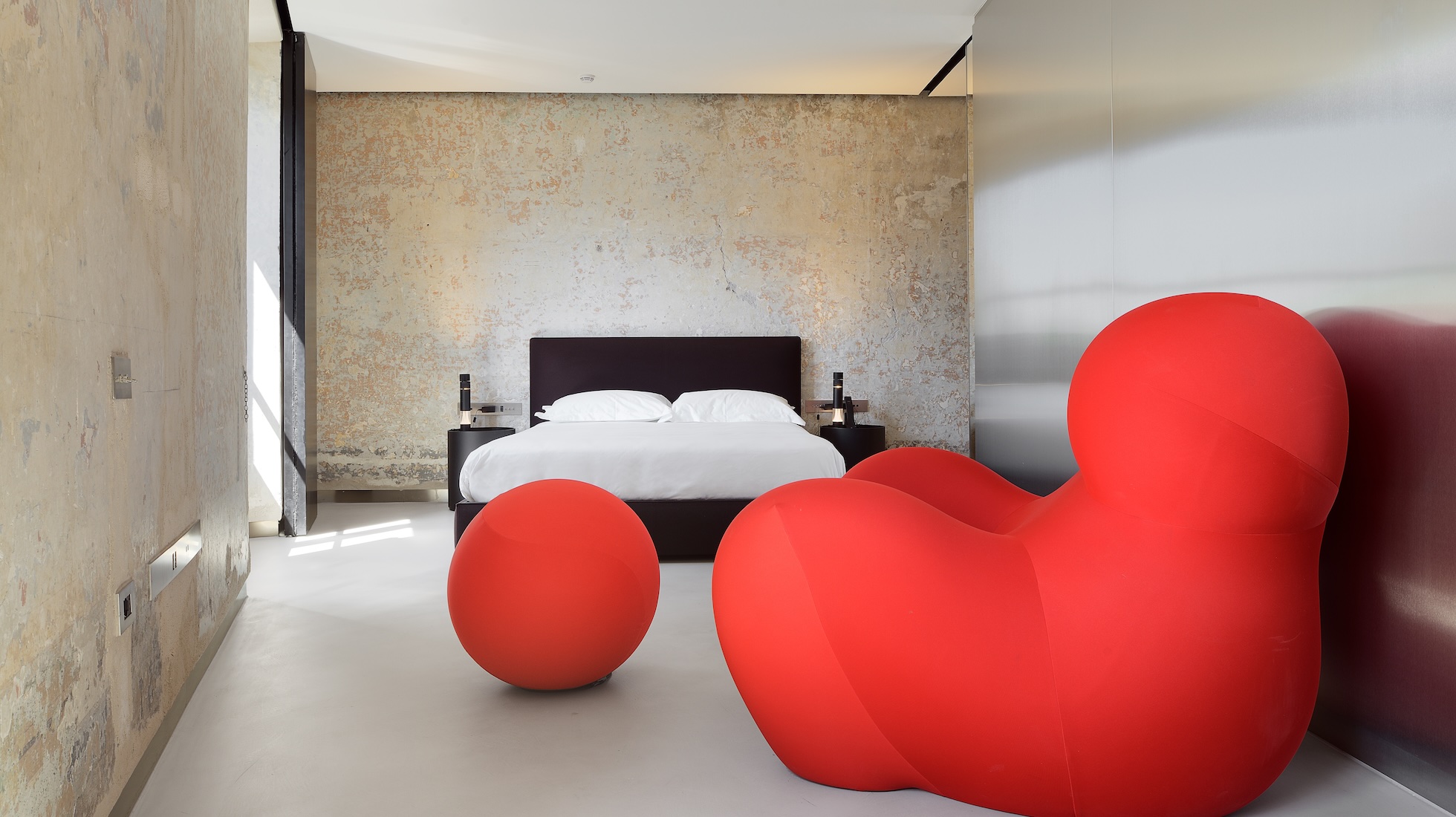Rhinoceros isn’t like any other hotel in Rome. Founded by Alda Fendi, of the eponymous Italian fashion dynasty, and designed by the acclaimed French architect Jean Nouvel, who also designed the Louvre Abu Dhabi and Torre Glòries skyscraper in Barcelona, the 25-apartment building in the Italian capital’s Velabro neighbourhood, near the Tiber river, is a masterpiece of artistic intent. Nouvel’s love of steel looms large in the hotel's self-contained apartments, juxtaposing exposed concrete walls, stucco and tiled flooring underfoot.
The six-storey palazzo, which dates from the 17th century, was once used as social housing, but in 2009 the municipality built newer (and easier to maintain) accommodations for the families that inhabited it. Alda Fendi bought the property in 2012, starting a meticulous, six-year-long restoration that left the original structure intact and the look of the building almost unchanged, if only observed from the exterior. Inside, however, guests have the feeling of entering a contemporary art museum.
The six-storey palazzo, which dates from the 17th century, was once used as social housing, but in 2009 the municipality built newer (and easier to maintain) accommodations for the families that inhabited it. Alda Fendi bought the property in 2012, starting a meticulous, six-year-long restoration that left the original structure intact and the look of the building almost unchanged, if only observed from the exterior. Inside, however, guests have the feeling of entering a contemporary art museum.

Rooms range from single apartments to a master suite | Credit: Rhinoceros
The lobby is understated – just a small standing desk and a lift to the rooms. Nouvel chose to use a mix of old and new materials: original stone, wood, cement, tiles and marble combined with stainless steel and occasional leather accents. The original features were preserved – such as the exposed stone walls and the wooden beams on the ceiling – giving the space a raw aesthetic that perfectly complements the modern design brought by large stainless steel elements such as kitchen units and wardrobes. Every room looks slightly different, but all of them feature standout pieces, from sofas by Philippe Starck to lights by Japanese designer Isamu Noguchi. The colour palette is strictly minimal, with shades of grey, black and white as the primary tones. The only vivid accent? Rhinoceros red, the hotel’s signature hue, which is also used in its logo.
The lobby is understated – just a small standing desk and a lift to the rooms. Nouvel chose to use a mix of old and new materials: original stone, wood, cement, tiles and marble combined with stainless steel and occasional leather accents. The original features were preserved – such as the exposed stone walls and the wooden beams on the ceiling – giving the space a raw aesthetic that perfectly complements the modern design brought by large stainless steel elements such as kitchen units and wardrobes. Every room looks slightly different, but all of them feature standout pieces, from sofas by Philippe Starck to lights by Japanese designer Isamu Noguchi. The colour palette is strictly minimal, with shades of grey, black and white as the primary tones. The only vivid accent? Rhinoceros red, the hotel’s signature hue, which is also used in its logo.
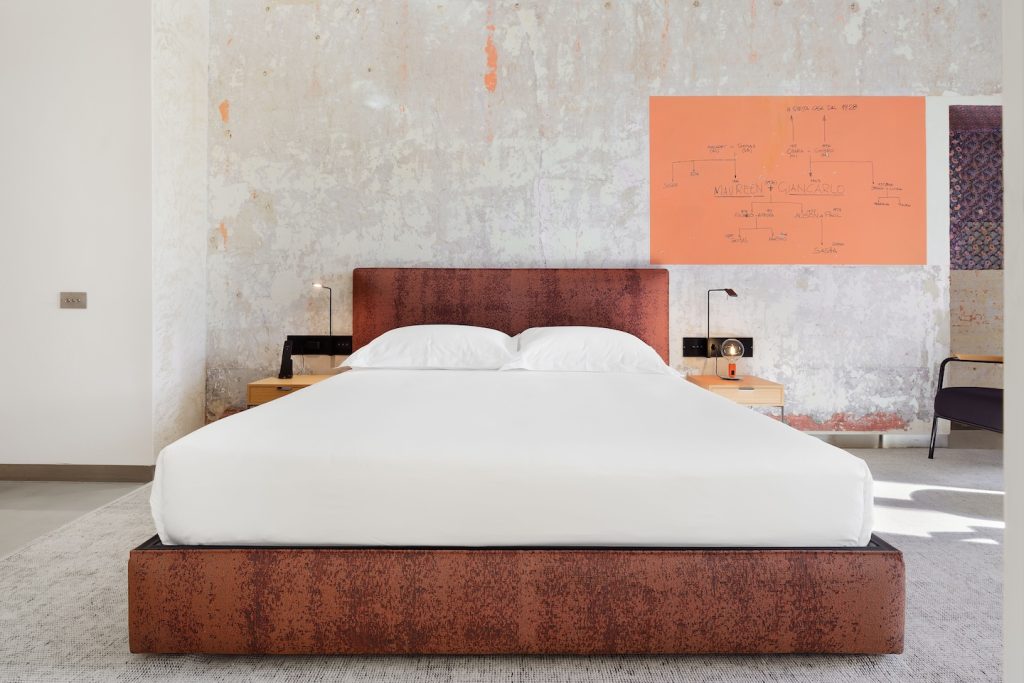
The hotel has 25 apartments, all slightly different in size and feel | Credit: Rhinoceros
Fendi’s project is as much about art as it is about hospitality. Alongside opening the hotel, she launched Fondazione Alda Fendi – Esperimenti on the same site, a non-profit arts foundation. The art gallery is located on the hotel’s ground floor and is accessible to the public as well as guests.
In 2025, Rhinoceros embarked on its artist residency programme, where artists stay in one of the apartments and create artworks inspired by the space, which are then exhibited in communal areas. The programme started in August, and the first participant to grace the hotel halls was Armenian multidisciplinary artist Sarko Meené, who filled the place with abstract flowers during our stay.
Fendi’s project is as much about art as it is about hospitality. Alongside opening the hotel, she launched Fondazione Alda Fendi – Esperimenti on the same site, a non-profit arts foundation. The art gallery is located on the hotel’s ground floor and is accessible to the public as well as guests.
In 2025, Rhinoceros embarked on its artist residency programme, where artists stay in one of the apartments and create artworks inspired by the space, which are then exhibited in communal areas. The programme started in August, and the first participant to grace the hotel halls was Armenian multidisciplinary artist Sarko Meené, who filled the place with abstract flowers during our stay.
Rooms
The 25 apartments are all slightly different in size and feel, but share the same use of materials – primarily, a striking contrast between stone and metal, alongside a boundary-pushing boldness. All come equipped with a fully functioning kitchen and a living area. Ours, number 23, featured a stainless steel kitchen that could be closed off to completely disappear from view, a compact yet cosy sofa and a spacious bathroom that featured an arresting metal bathtub, two sinks and toiletries by the Neapolitan brand Acampora (in refillable bottles). The blinds were made from panels printed with photos taken of the room before its renovation, honouring the building’s past.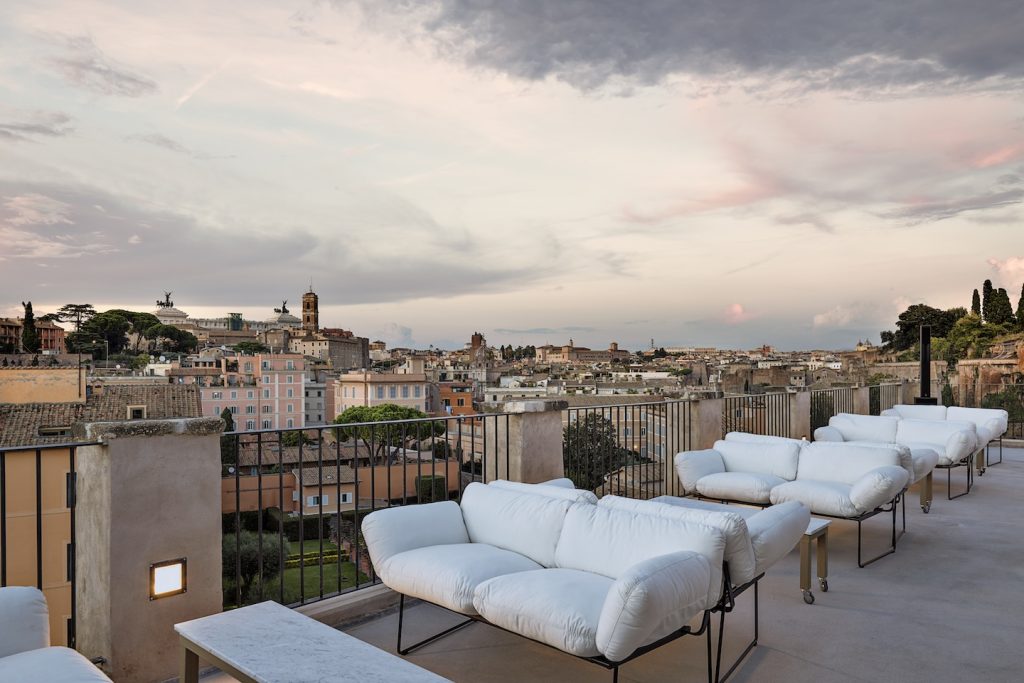
The hotel’s rooftop bar and restaurant | Credit: Rhinoceros
Every room is stocked with a selection of classic breakfast ingredients, including eggs, ham, milk, cheese, jams, yoghurt and granola, as well as fresh fruit (our bounty included a selection of strawberries, grapes and prunes). You’ll be asked in advance when you would like to receive your bread and pastry basket delivery in the morning, with no time restriction, so feel free to request your basket for 6am, 12pm or even 4pm.
When we opened the door in the morning, at exactly the time requested, we found two large maritozzi (Rome’s iconic cream buns) overflowing with fresh Chantilly cream. We knew then that we wouldn’t be missing the buffet.
Dishes offer an updated spin on Italian classics, championing produce found throughout Rome’s historic cuisine, all presented with artistic flourish. A highlight on our visit was the anchovies and chicory cold starter, accompanied by battered and fried anchovies dusted with a delicate snow of pecorino cheese. Oh, and the ravioli – filled with pecorino, black pepper and ricotta, and served on a bed of lamb tartare.
What’s for breakfast?
Like most people, we love a hotel breakfast, and wondered how Rhinoceros would be able to match the sprawling buffets and perfectly executed omelettes usually found in five-star establishments. Luckily, it delivers.Every room is stocked with a selection of classic breakfast ingredients, including eggs, ham, milk, cheese, jams, yoghurt and granola, as well as fresh fruit (our bounty included a selection of strawberries, grapes and prunes). You’ll be asked in advance when you would like to receive your bread and pastry basket delivery in the morning, with no time restriction, so feel free to request your basket for 6am, 12pm or even 4pm.
When we opened the door in the morning, at exactly the time requested, we found two large maritozzi (Rome’s iconic cream buns) overflowing with fresh Chantilly cream. We knew then that we wouldn’t be missing the buffet.
How about lunch and dinner?
The restaurant (and cocktail bar) is located on the top floor and has a gorgeous terrace, with jaw-dropping views of the honey-hued city, including of a fair few classical landmarks. It’s a fine-dining experience – and it’s definitely costly compared to the average prices in town – with guests choosing between tasting menus and an à la carte service.Dishes offer an updated spin on Italian classics, championing produce found throughout Rome’s historic cuisine, all presented with artistic flourish. A highlight on our visit was the anchovies and chicory cold starter, accompanied by battered and fried anchovies dusted with a delicate snow of pecorino cheese. Oh, and the ravioli – filled with pecorino, black pepper and ricotta, and served on a bed of lamb tartare.
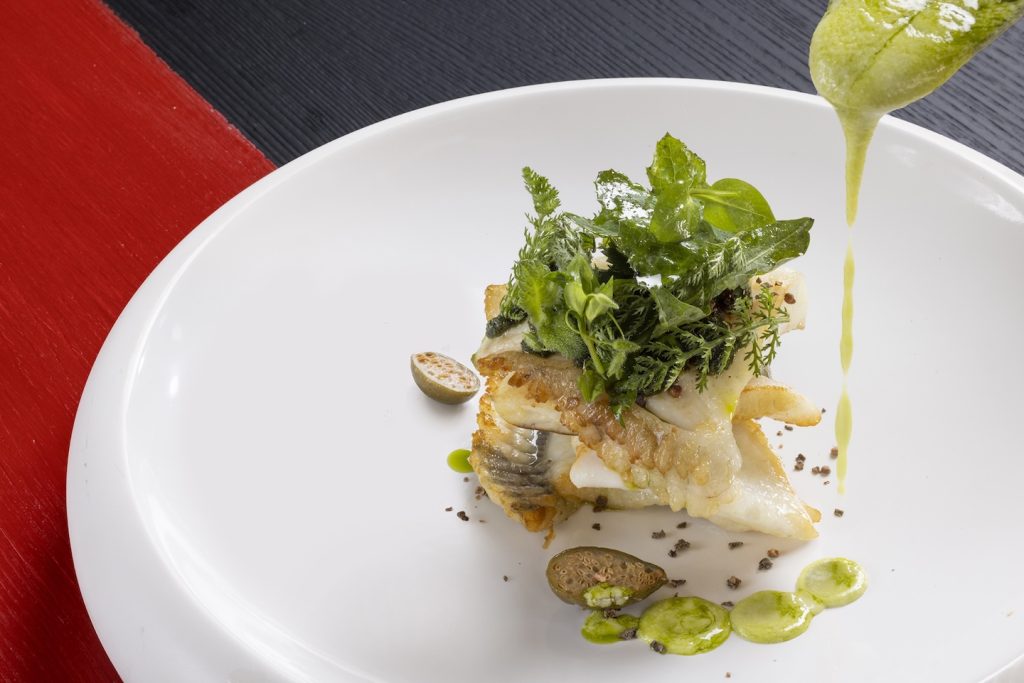
The menu offers an updated take on Italian classics | Credit: Rhinoceros
Is there a bar?
The bar, situated next to the restaurant, offers all the classics, plus eight signature cocktails. These are divided into three categories, each inspired by a different species of rhinoceros. Views from the bar’s terrace are stunning, making it the perfect place to start or finish an evening in the Eternal City.Amenities
Amenities are a little thin on the ground, but while there’s no gym or spa, guests enjoy access to the contemporary art gallery downstairs, where you can browse (and buy) to your heart’s content. The hotel doesn’t have a traditional lobby, either, but there is a 24-hour concierge service in operation.What are the hotel’s eco credentials?
Rev up your Roman driving skills: the hotel has a fleet of small electric cars, RhinoRide Electric Vehicles, which guests can book for €30 an hour to explore the surrounding streets.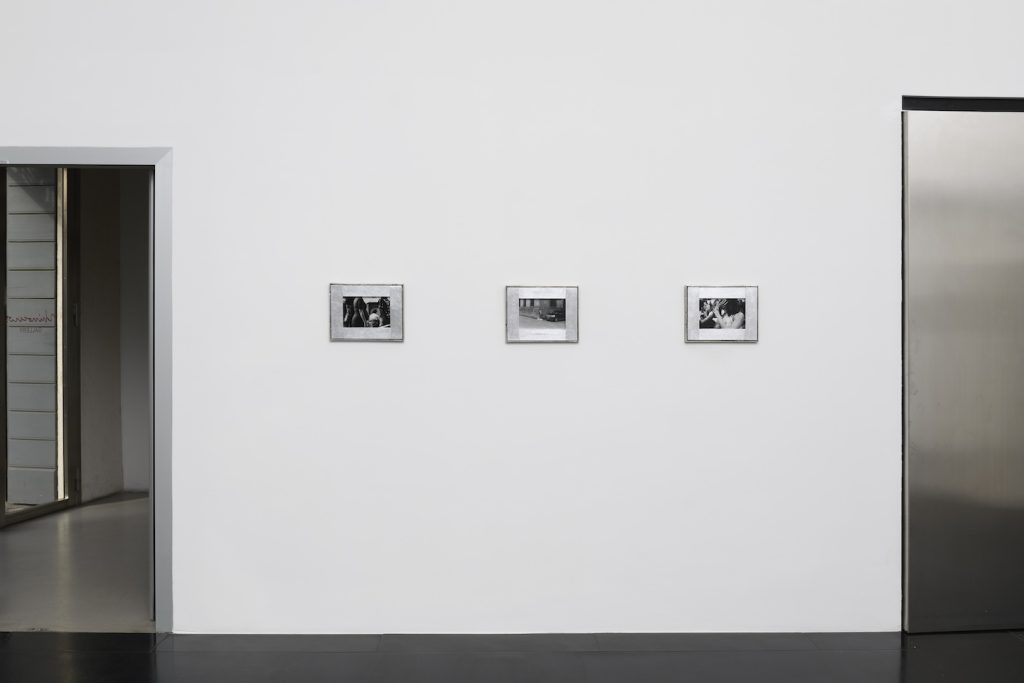
Guests have free access to the hotel’s contemporary art gallery | Credit: Rhinoceros Gallery and Francois Ghebaly
Accessibility
Two of the 25 apartments are accessible for wheelchair users, as are the majority of communal spaces throughout. The majority of rooms can be reached via a lift.What’s the crowd like?
Cool, artsy and fabulously stylish. Guests who choose to stay here are creatives seeking the ambience and luxury of a five-star hotel without the stuffiness that often comes with it. Here, the most important thing is attention to detail, rather than etiquette.Things you should know
Note that Rhinoceros operates more like a luxury apartment complex than a hotel. Service is impeccable, but don’t expect all the trimmings of a more traditional stay.Within a short walk I can find…
It would be hard to find a better location in Rome. The fourth-century Arch of Janus is located directly in front of the hotel building, while the Arcus Argentariorum and the Church of San Giorgio are just a stone’s throw away. The unmissable Mouth of Truth is a three-minute walk away, as is the Circus Maximus. In less than 10 minutes, you can get to one of Rome’s most beautiful parks, the Orange Trees Garden (Il Giardino degli Aranci), while most of the city’s must-see landmarks, including the Colosseum, the Trevi Fountain and Piazza Navona, can be reached within 20 minutes. A half-hour walk will take you to the Spanish Steps, while Saint Peter’s Basilica is around 40 minutes away on foot. For food, drinks and shopping, the buzzing neighbourhood of Trastevere sits just across the river.The Lowdown
Apartments cost from £347 a night, excluding city tax; rhinocerosroma.com



